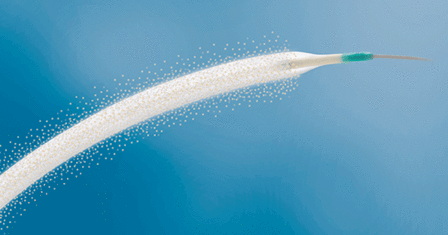Noticias


- Título: BIOTRONIK Announces New Study Evaluating Efficacy of Combined Pulsar-18 Stent and Passeo-18 Lux Balloon in Treating SFA Disease
- Fecha: 17-07-2014
Vascular Intervention
BIOLUX 4EVER Study Aims to Build on Positive Results of BIOLUX P-I and 4EVER Trials
BUELACH, Switzerland, July 17, 2014 – BIOTRONIK, a leading manufacturer of cardio- and endovascular devices, today announced that the first patient has been enrolled in the investigator-initiated BIOLUX 4EVER trial. Given the positive results from each of the previous drug releasing balloon (DRB) and self-expanding stent (SES) trials, investigators were interested in exploring the combined use of the Pulsar-18 SES and Passeo-18 Lux DRB to see if the outcome could be improved further. BIOLUX 4EVER will follow the study design of the previously completed, investigator-initiated 4EVER trial, which examined the efficacy of the Pulsar-18 SES in the treatment of Superficial Femoral Artery (SFA) lesions, but this time adding the Passeo-18 Lux DRB to the treatment. The study will enroll 120 patients treated with both products, with the primary endpoint of primary patency at 12 months.“Studying these two devices in combination is a novel idea,” explained principal investigator Dr. Marc Bosiers, St. Blasius Hospital, Dendermonde, Belgium. “Previous studies of each device have yielded encouraging results, but we wanted to go one step further. Now, patients will be treated with both the Pulsar-18 stent and the Passeo-18 Lux, hopefully pushing the results off the charts.”
BIOLUX P-I was the first in-human study investigating the performance of the Passeo‑18 Lux DRB compared to an uncoated Passeo-18 balloon catheter in the treatment of SFA lesions. At 12 months, freedom from Target Lesion Revascularization (TLR) was achieved in 84.6 percent of DRB patients and 58.3 percent of PTA patients. The 4EVER study investigated both the acute and long-term performance of 4F-compatible devices in treating SFA lesions. The study examined the efficacy of Pulsar stents and the feasibility of treating patients with BIOTRONIK 4F devices. Twenty-four-month data from 4EVER for the full cohort of 120 patients showed an impressive 72.3 percent primary patency rate and a freedom from TLR rate of 82.7 percent with no significant difference between calcified and non-calcified lesions.
“The Pulsar-18 stent and Passeo-18 Lux DRB are two of our most important and forward-looking technologies,” commented Dr. Alexander Uhl, BIOTRONIK Vice President Marketing, Vascular Intervention. “The Pulsar-18 features a highly flexible, low chronic outward force design and low-profile 4F delivery system. Meanwhile, the DRB’s specially designed insertion aid has been praised by physicians for improving ease of handling while protecting the user and balloon coating from contact and damage. These innovations point to the commitment to technical excellence that BIOTRONIK stands for, and lead us to expect promising results from this new study.”
About Pulsar-18
Pulsar stents feature an innovative, highly flexible design coated with proBIO, a silicon carbide layer that improves the stent's hemocompatibility and biocompatibility, which is believed to contribute to its excellent clinical results. Pulsar-18 is available in diameters of 4-7 mm and lengths of 20-200 mm, all deliverable through a 4F sheath.
About Passeo-18 Lux
Passeo-18 Lux is a novel combination device for treating de novo and restenotic lesions in the infrainguinal arteries. Its design is based on that of the proven Passeo-18 uncoated balloon catheter, combined with a balloon coating containing a matrix of anti-proliferative paclitaxel and Butyryl-Tri-Hexyl-Citrate, a biocompatible excipient to enable optimal drug transfer to the target lesion tissue. This coating is also applied to Pantera Lux, a clinically proven coronary drug-releasing balloon. Passeo-18 Lux also features a unique insertion aid, which improves ease of handling and protects the user and balloon coating from contact and damage. After use, the insertion aid can simply be peeled away.
About BIOTRONIK
One of the world’s leading manufacturers of cardio- and endovascular medical devices, BIOTRONIK is headquartered in Berlin, Germany, and represented in over 100 countries by its global workforce of more than 5,600 employees. Several million patients have received BIOTRONIK implants designed to save and improve the quality of their lives, or have been treated with BIOTRONIK coronary and peripheral vascular intervention products. Since its development of the first German pacemaker in 1963, BIOTRONIK has engineered many innovations, including BIOTRONIK Home Monitoring®; the world’s first 4F-compatible 200 mm peripheral stent; Orsiro, the industry’s first hybrid drug-eluting stent; and the world’s first implantable cardioverter-defibrillators and heart failure therapy devices with ProMRI® technology.For more information, visit: www.biotronik.com
Contact:
Manuela Schildwächter
Senior Manager Communications & PR
BIOTRONIK SE & Co. KG
Woermannkehre 1
12359 Berlin, Germany
Tel. +49 (0) 30 68905 1414
Email: press@biotronik.com- Fuente: endovascular.es





